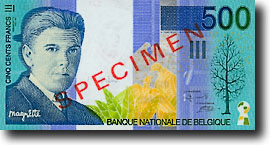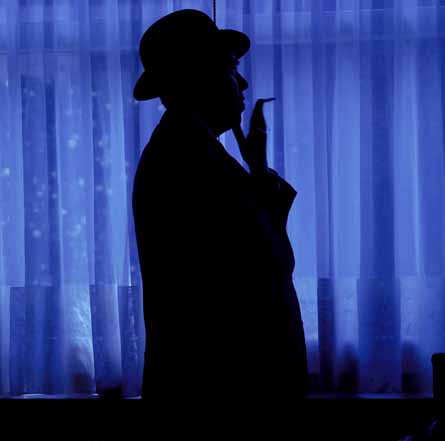René François Ghislain Magritte (Lessines, November 21, 1898 - Brussels, August 15, 1967) was a leading Belgian surrealist artist, alongside Paul Delvaux.
Rene Magritte's Biography
Magritte was born in Lessines, Belgium, on November 21, 1898, the youngest son of Léopold Magritte. In 1912, his mother, Régina, committed suicide by drowning in the Sambre River.
In 1916, he entered the Royal Academy of Fine Arts in Brussels, where he studied for two years. It was during this period that he met Georgette Berger, whom he married in 1922.
He worked in a wallpaper factory, and was a designer of posters and advertisements until 1926, when a contract with the Galerie la Centaure in the Belgian capital made painting his main activity. That same year, Magritte produced his first surrealist painting, Le jockey perdu, and his first exhibition was shown the following year.
René Magritte practiced both realist surrealism and magic realism. He began to imitate the avant-garde, but really needed a more poetic language and found himself influenced by the metaphysical painting of Giorgio de Chirico.
Magritte had a mischievous spirit, and in The Fall, his bizarre men in bowler hats plummet from the sky absolutely serene, expressing something of life as we know it.
His art, painted with such sharpness that it looks very, very realistic, typifies the Surrealist love of visual paradoxes: while things may give the impression of being normal, there are anomalies everywhere: The Fall has a strange exactness, and Surrealism is attractive precisely because it explores our hidden understanding of earthly weirdness.
He moved to Paris in 1927, where he began to become involved in the activities of the Surrealist group, becoming close friends with the poets André Breton and Paul Éluard and the painter Marcel Duchamp.
When Galerie la Centaure closed and his contract ended, Magritte returned to Brussels. He remained in the city even during the German occupation in World War II.
His work was exhibited in 1936 in New York City, United States, and in two more retrospective exhibitions in that same city, one at the Museum of Modern Art in 1965 and another at the Metropolitan Museum of Art in 1992.
Magritte died of cancer in 1967 and was buried in Schaerbeek Cemetery.
Works and Characteristics of Rene Magritte
A painter of unusual images, to which he gave rigorously realistic treatment, he used illusionist processes, always looking for the contrast between the realistic treatment of objects and the unreal atmosphere of the sets.
His works are metaphors that present themselves as realistic representations, through the juxtaposition of common objects, and recurring symbols in his work, such as the female torso, the bowler hat, the castle, the rock and the window, among others, but in a way impossible to be found in real life.
Surrealist painter René Magritte was part of an artistic movement called Surrealism, named after the desire of many young painters in the mid-1920s to create a reality through paintings that transcended reality itself. In other words, the artists created an artistic movement that depicted a more real reality that they were surrounded by.
This was because the artists of the time had a feeling that there was something wrong with the demands that the classical academy of painting made on artists to paint exactly what was being seen before their eyes.
One of the Belgian painter's works in which it is possible to perceive reality being created is the work "Attempting the impossible" (oil on canvas -1928). In this work, an artist is painting a woman. He always looks like the painter himself, that is, Magritte. In the work, the artist paints in the "air", thus creating, using a brush and a color palette, a three-dimensional woman.
The creation of this woman is totally illusory because the painting remains in two planes. This work dialogues with the surrealist movement to which the artist belongs because it uses a self metalanguage, in which the painter (Magritte) paints himself portraying a painting. He thus creates, in the painting, a reality as real as his own.
In other words, by portraying what is being seen, the artist ends up creating his own reality that is made based on the artist's strokes and impressions of the human body being portrayed. The painter, in other words, is not copying a reality, but creating a new one, in the same way as with human dreams, in which the reality created in dreams is, for a certain moment in the dreaming, more real than reality itself.
Because of the wave of classical works that was happening in the world, the painters and artists of the 20th century needed to invent new ways of making art. To have a chance to catch the attention of the academy and critics, artists needed to be great inventors of both form and content to distance themselves from the Renaissance painters and sculptors that the world and the academy came to admire and follow as the standard of art.
Any departure from the Renaissance tradition that simultaneously aroused the interest of art critics and attracted followers was applauded. The 20th century in the arts was marked by a constant, tireless experimentation by artists in the way they painted, with the aim of generating new art.
Rene Magritte's Gallery
Magritte Museum...
...in Brussels.
Obverse and reverse of a banknote of...
...500 Belgian francs.
Photo of Magritte by Lothar Wolleh.
Well-known paintings of Rene Magritte
- La trahison des images
- The Empire of Light
- Le fils de l'homme
- Ceci n'est pas une pomme
Auctions
On March 2, 2022, the painting "L'Empire des Lumieres" ("The Empire of Lights") was sold at Sotheby's auction for 51.5 million pounds. The work, from 1961, depicts a night street under a bright blue sky.





